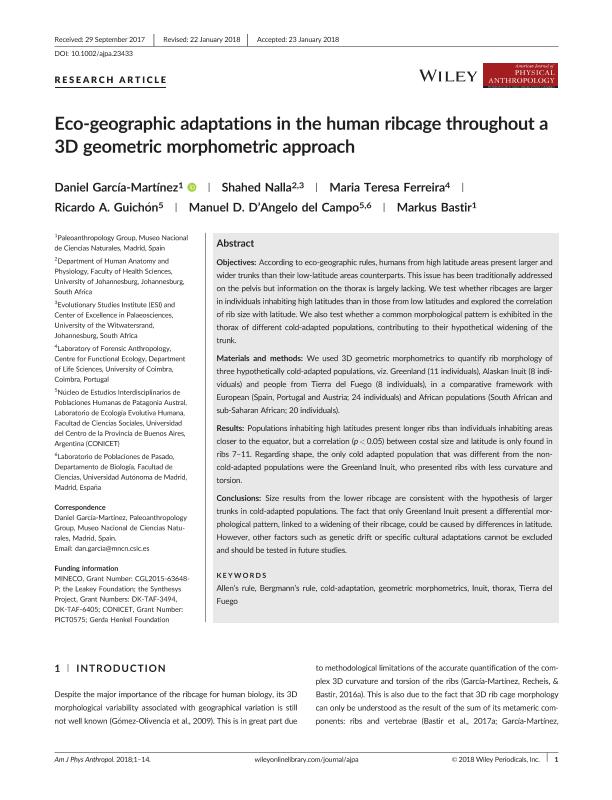Mostrar el registro sencillo del ítem
dc.contributor.author
García Martínez, Daniel
dc.contributor.author
Nalla, Shahed
dc.contributor.author
Ferreira, Maria Teresa
dc.contributor.author
Guichon, Ricardo Anibal

dc.contributor.author
D'Angelo del Campo, Manuel D.
dc.contributor.author
Bastir, Markus

dc.date.available
2020-08-21T15:10:35Z
dc.date.issued
2018-02
dc.identifier.citation
García Martínez, Daniel; Nalla, Shahed; Ferreira, Maria Teresa; Guichon, Ricardo Anibal; D'Angelo del Campo, Manuel D.; et al.; Eco‐geographic adaptations in the human ribcage throughout a 3D geometric morphometric approach; Veterinary and Human Toxicology; American Journal Of Physical Anthropology; 166; 2; 2-2018; 323-336
dc.identifier.issn
0002-9483
dc.identifier.uri
http://hdl.handle.net/11336/112124
dc.description.abstract
Objectives: According to eco-geographic rules, humans from high latitude areas present larger and wider trunks than their low-latitude areas counterparts. This issue has been traditionally addressed on the pelvis but information on the thorax is largely lacking. We test whether ribcages are larger in individuals inhabiting high latitudes than in those from low latitudes and explored the correlation of rib size with latitude. We also test whether a common morphological pattern is exhibited in the thorax of different cold-adapted populations, contributing to their hypothetical widening of the trunk.Materials and methods: We used 3D geometric morphometrics to quantify rib morphology of three hypothetically cold-adapted populations, viz. Greenland (11 individuals), Alaskan Inuit (8 individuals) and people from Tierra del Fuego (8 individuals), in a comparative framework with European (Spain, Portugal and Austria; 24 individuals) and African populations (South African and sub-Saharan African; 20 individuals).Results: Populations inhabiting high latitudes present longer ribs than individuals inhabiting areas closer to the equator, but a correlation (p < 0.05) between costal size and latitude is only found in ribs 7-11. Regarding shape, the only cold adapted population that was different from the non-cold-adapted populations were the Greenland Inuit, who presented ribs with less curvature and torsion.Conclusions: Size results from the lower ribcage are consistent with the hypothesis of larger trunks in cold-adapted populations. The fact that only Greenland Inuit present a differential morphological pattern, linked to a widening of their ribcage, could be caused by differences in latitude. However, other factors such as genetic drift or specific cultural adaptations cannot be excluded and should be tested in future studies.
dc.format
application/pdf
dc.language.iso
eng
dc.publisher
Veterinary and Human Toxicology

dc.rights
info:eu-repo/semantics/openAccess
dc.rights.uri
https://creativecommons.org/licenses/by-nc-sa/2.5/ar/
dc.subject
ALLEN´S RULE
dc.subject
BERGMANN´S RULE
dc.subject
INUIT- TIERRA DEL FUEGO COLD ADAPTATION
dc.subject
GEOMETRIC MORPHOMETRICS; THORAX
dc.subject.classification
Otras Historia y Arqueología

dc.subject.classification
Historia y Arqueología

dc.subject.classification
HUMANIDADES

dc.title
Eco‐geographic adaptations in the human ribcage throughout a 3D geometric morphometric approach
dc.type
info:eu-repo/semantics/article
dc.type
info:ar-repo/semantics/artículo
dc.type
info:eu-repo/semantics/publishedVersion
dc.date.updated
2020-08-19T18:46:23Z
dc.journal.volume
166
dc.journal.number
2
dc.journal.pagination
323-336
dc.journal.pais
Estados Unidos

dc.journal.ciudad
New York
dc.description.fil
Fil: García Martínez, Daniel. Museo Nacional de Ciencias Naturales; España
dc.description.fil
Fil: Nalla, Shahed. University of Johannesburg; Sudáfrica. University of the Witwatersrand; Sudáfrica
dc.description.fil
Fil: Ferreira, Maria Teresa. Universidad de Coimbra; Portugal
dc.description.fil
Fil: Guichon, Ricardo Anibal. Consejo Nacional de Investigaciones Científicas y Técnicas. Centro Científico Tecnológico Conicet - Tandil; Argentina. Universidad Nacional del Centro de la Provincia de Buenos Aires. Facultad de Ciencias Sociales. Departamento de Arqueología. Laboratorio de Ecología Evolutiva Humana (Sede Quequén); Argentina
dc.description.fil
Fil: D'Angelo del Campo, Manuel D.. Universidad Nacional del Centro de la Provincia de Buenos Aires. Facultad de Ciencias Sociales. Departamento de Arqueología. Laboratorio de Ecología Evolutiva Humana (Sede Quequén); Argentina. Universidad Autónoma de Madrid; España
dc.description.fil
Fil: Bastir, Markus. Museo Nacional de Ciencias Naturales; España
dc.journal.title
American Journal Of Physical Anthropology

dc.relation.alternativeid
info:eu-repo/semantics/altIdentifier/url/https://onlinelibrary.wiley.com/doi/abs/10.1002/ajpa.23433
dc.relation.alternativeid
info:eu-repo/semantics/altIdentifier/doi/http://dx.doi.org/10.1002/ajpa.23433
Archivos asociados
